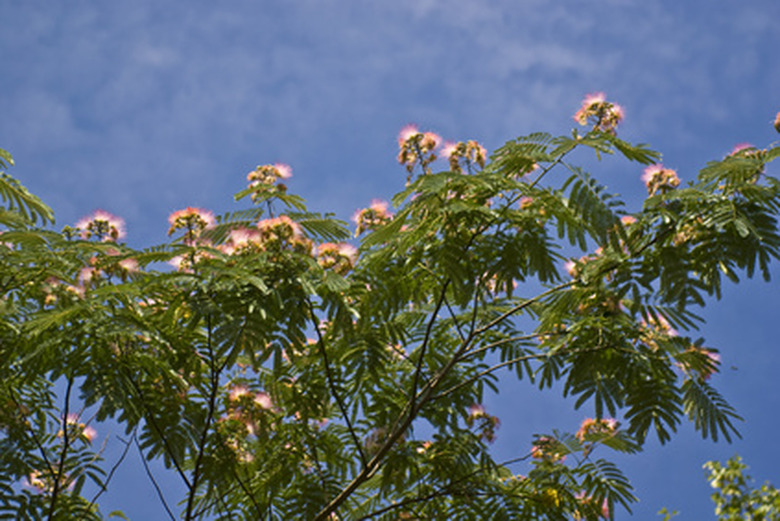Mimosa Tree Leaf Identification
The mimosa tree, also known as the silk tree, an ornamental introduced from China into North America in 1745, has an unusual tropical appearance. This is because of its leaves, which easily stand out against the more mundane foliage of the typical trees in areas where the mimosa now grows, mostly in southeastern parts of the United States. The mimosa tree is a naturalized species, escaping from people's yards via the dispersal of its seeds and developing in open areas, woodlands and waste places such as vacant lots and roadsides.
Bipinnately Compound Leaves
The leaves of the silk tree are bipinnately compound. The term compound leaf refers to a single leaf composed of multiple parts, where a long stem and individual attached leaflets comprise one single leaf. The stem, the rachis, attaches to the branch of the tree. Trees such as hickories, boxelder and walnut have compound leaves. In the case of the mimosa tree, the leaves are doubly compound. In this scenario, a series of stems attaches to the rachis. Many small leaflets grow upon these stems that branch off the main rachis, making it appear as if the leaves are ferns dangling from the branches.
- The mimosa tree, also known as the silk tree, an ornamental introduced from China into North America in 1745, has an unusual tropical appearance.
- This is because of its leaves, which easily stand out against the more mundane foliage of the typical trees in areas where the mimosa now grows, mostly in southeastern parts of the United States.
Size
The size of the main rachis on the mimosa trees varies, with some as short as six inches and others as long as 20 inches. The multiple stems that extend off the main rachis, known as pinnae, are from five to eight inches in length. On these stems are the individual leaflets that can grow to 5/8 in. in length and be ¾ in. wide.
Pinnae and Leaflets
The rachis can contain from 10 to 25 pinnae on the main rachis, according to the Invasive Plants of the Eastern United States website. Upon these stems there will be anywhere from 15 to 30 pairs of the small leaflets, growing opposite each other on the stem.
- The size of the main rachis on the mimosa trees varies, with some as short as six inches and others as long as 20 inches.
- The rachis can contain from 10 to 25 pinnae on the main rachis, according to the Invasive Plants of the Eastern United States website.
Considerations
The leaflets growing on the pinnae are oblong and are a pale green color. The leaves on the mimosa tree grow in an alternate manner from the branches. One main rachis develops at a node on the branch, with the next node having just one rachis as well. This pattern and the overall appearance of the compound leaves gives the mimosa tree a feathery look, says the Center for Aquatic and Invasive Plants website.
Effects
One of the reasons that the mimosa is classified as an invasive plant is the effects its leaves have in preventing sunlight from reaching the ground beneath the tree. The leaves grow close together, and the many leaflets combine to screen the sun from the ground. This keeps native plant life from getting the required amount of sun for growth, reports the National Park Service's website.
- The leaflets growing on the pinnae are oblong and are a pale green color.
- The leaves grow close together, and the many leaflets combine to screen the sun from the ground.
References
- National Park Service: Silktree
- Center for Aquatic and Invasive Plants: Mimosa Tree
- Invasive Plants of the Eastern United States: Southeast Exotic Pest Plant Council Invasive Plant Manual
- "National Audubon Society Field Guide to Trees"; Elbert L. Little; 2008
- "Trees of North America"; C. Frank Brockman; 1996
